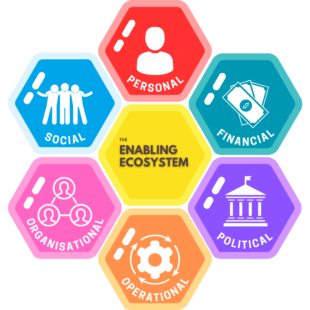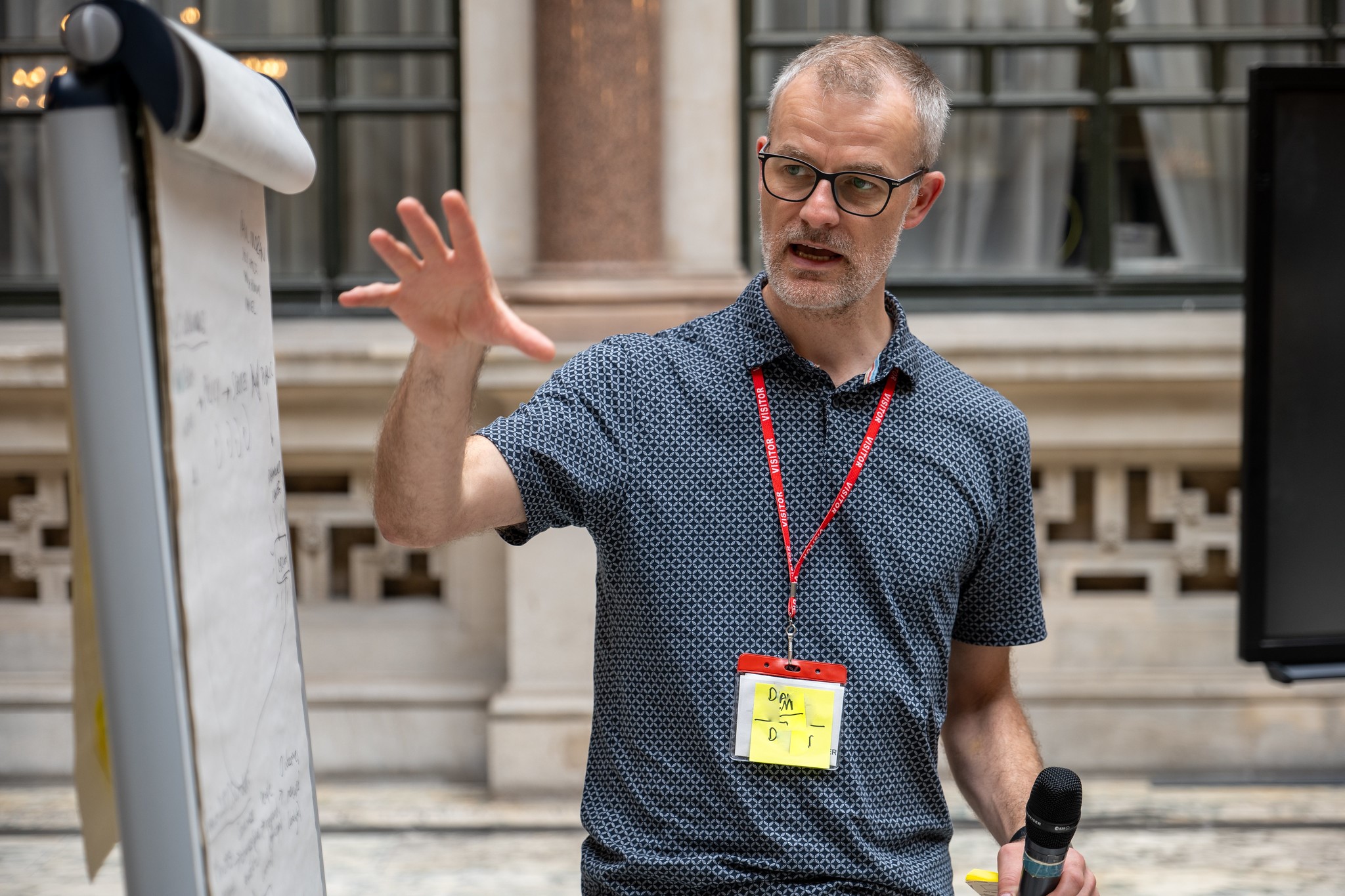Public entrepreneurs must be able to navigate and influence both social and political spheres in order to succeed. These are fundamental skills for innovating public systems and form part of the Enabling Ecosystem.
 This is the third of four blog posts describing my experiences in establishing and running the Innovation Lab (iLab) in the Department of Finance in Northern Ireland. Previously I described your role as a public entrepreneur working in the Enabling Ecosystem, but success also requires successful engagement with people and politicians.
This is the third of four blog posts describing my experiences in establishing and running the Innovation Lab (iLab) in the Department of Finance in Northern Ireland. Previously I described your role as a public entrepreneur working in the Enabling Ecosystem, but success also requires successful engagement with people and politicians.
Secure public buy-in
The social segment of the Enabling Ecosystem is the public arena for innovation, within which you must secure public buy-in and into which the innovation must successfully land. It is made up of businesses, citizens and communities impacted by, benefiting from your innovation or even constrained by it. It is in this environment that the outcomes you wish to achieve are likely to be needed and will, at least potentially, be realised. Is there, however, an appetite for change within the impacted communities or at public opinion level?
Here are some factors that you might consider when engaging with the public…
Community Engagement
Here the initial question is not about the actual innovation but rather whether the user community sees the need for change or if it is likely to become a major impediment to it? This is a complex area and one where the opposition should not be underestimated. Often this part of the ecosystem will be emotionally charged, controversial and be populated by opposing constituencies of influencers, many of whom will be wedded to the status quo, even though by every rational measure the case for change is compelling. This opposition may be fanned by the media, focusing on the negatives rather than the positive case for change.
You will need to consider if there are good linkages into the user community to fully engage them in the innovation process, involving them in all phases. Might you lever the energy and support of voluntary sector organisations or elected representatives? Bear in mind, however, that you will need to ensure balanced representation, so to avoid biased engagement – remember that each voluntary sector body will have an agenda of its own to promote.
Lessons from other jurisdictions
Seek examples of successful reform and change in a similar setting, that have occurred in other jurisdictions, and from which learning might be derived, and through which positive, independent external influence might be brought to bear.
User-Centred Design – engaging directly with service users
Have you factored into your thinking that for real innovation, you must start with the people whose lives you wish to positively impact with innovation? Successful innovation finds its origins in user-centred design, involving user research, engagement and participation throughout the innovation life- cycle. Are you really willing to invest in this to help ensure you have a viable, deliverable and useable innovation that will produce the results you expect and which you can reasonably expect to deliver? Your department’s policy design experts can support this aspect of a project; and courses on Service Design are available through a wide range of commercial organisations
Have you considered the cost of failing to engage with service users, which may leave you having to implement the change into a difficult, fractious, and fragmented public arena? We are all too familiar with the typical adverse reaction to the closure and centralisation of public services for example. We can all think of public protests and campaigns to retain a local service, which by all other metrics is no longer viable.
Of course, I don’t want to make it sound simple; it isn’t. In fact, it is complex and challenging, and you may end up having to either abandon your plans or dilute them significantly. Consider how many times attempts have been made to reform some public services, only for the change to be abandoned, delayed, or watered down.
Opposing Forces
Another consideration is to ask if the social segment of the ecosystem is cohesive, and collaborative? Or are there groups with different and even horizontally opposed views, and will you need to first act as a catalyst to bring the players together to co-create and implement the solution? It is worth noting that in some recent iLab projects it became evident that a collaborative approach aimed at getting an agreed solution was not going to succeed because of polarized views amongst stakeholders. In such cases, it may be that the only way forward is for government to legislate.
Working with politicians
The political part of the Enabling Ecosytem for innovation is the world of publicly elected representatives in which you operate and whose buy-in, approval and even sponsorship, might be needed. This might be at council, regional or national level. Inevitably, and depending on the level you are working at, it may form a significant part of your ecosystem.
In a liberal democracy, our role as public servants is to respond to the direction of the publicly elected representatives, which, in some instances, may bring a particular political ideology to bear, and which may of itself shape the direction of innovation.
This aspect of the ecosystem becomes more complicated when innovation is needed at system level, requiring collaboration across departmental boundaries (and therefore across Ministerial portfolios). It will be essential to both understand the complex array of stakeholder interests and to secure the enabling permissions needed to begin to innovate in this context.
Political Ambition and Transformative Change
There may be a tension between political ambition and the capacity/capability of the system to respond at pace. There have been some projects where political ambition at the time by far outstripped the available or emerging technology, or the capacity within the system to deliver – in her book Called to Account Dame Margaret Hodge comments on this particular point in connection with the introduction of the UK’s Universal Credit scheme.
Sometimes politicians are suspicious that the advice they are getting is simply delaying tactics, part of the creative inertia within the system. In this context the question arises about freedom to ‘speak truth to power’ and the willingness of politicians to take account of advice that may not sit well with their priorities, and election cycles.
Some changes are tactical and can be achieved in a shorter timescale. But think of some of the deep-rooted social issues (the wicked problems), which are complex and persist despite much effort and investment. These are very unlikely to be resolved easily or quickly; they require system wide transformation and there has to be a realistic ambition in your mind, which you will need to articulate; otherwise you end up in a ‘mission impossible’ situation, trying to satisfy political ambition, when it is patently obvious that it cannot be achieved in the expected timeframe.
The complexity and the challenges of operating in this segment requires skills and capabilities beyond my knowledge and personal experience. You will need to take advice on these matters from senior and experienced colleagues and there are courses available to give greater insight on how to operate successfully in this part of the ecosystem.
What’s next?
In my final blog post, I will look at the financial, the organisational and the operational segments of the Enabling Ecosystem.
Join our community
We use this blog to talk about the work of the multidisciplinary policy design community. We share stories about our work, the thinking behind it and what policymaking might look like in the future. If you would like to read more, then please subscribe to this blog. If you work for the UK’s government, then you can you join the policy design community. If you don’t work for the UK government, then join our AHRC Design and Policy Network.











